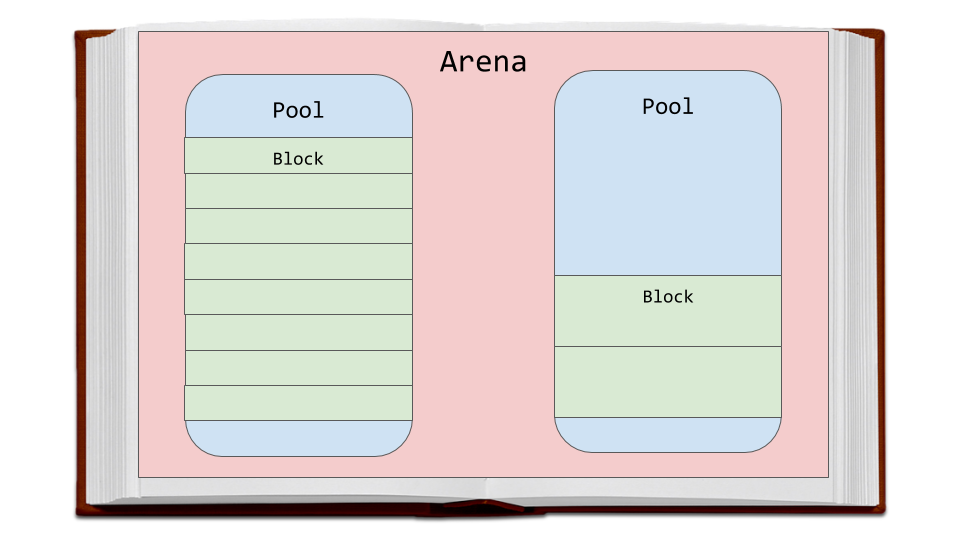【Python数据结构内存剖析】:深入探索内存布局与优化技巧
发布时间: 2024-09-11 20:35:35 阅读量: 187 订阅数: 46 


# 1. Python数据结构概述
Python,作为一种功能强大的编程语言,提供了丰富而灵活的数据结构,以满足不同场景下的数据存储和操作需求。在这一章节中,我们将深入浅出地了解Python的基本数据结构,包括其定义、特点及应用场景。通过这一章节的介绍,读者将对Python数据结构有一个全面的初步认识,并为进一步深入学习打下坚实的基础。
Python中的数据结构主要分为两大类:基本数据类型和复合数据类型。基本数据类型包括数字类型、布尔类型和字符串类型;复合数据类型则包括列表、元组、字典和集合等。每一种数据结构都有其独特的属性和方法,例如列表支持动态的元素增加与删除,而元组则提供不可变的序列,确保数据的稳定性和安全性。我们将在后续章节中详细讨论这些数据结构的内部实现及其内存布局。
接下来的章节将引导大家进入Python数据结构的奇妙世界,探索它们如何在内存中存储和操作,以及如何通过这些知识来优化我们的Python代码。无论你是Python初学者,还是需要进一步提升技能的中高级开发者,本章都将是学习之旅的良好起点。
# 2. Python内置数据结构的内存布局
Python作为一门高级编程语言,其内置的数据结构被广泛应用于日常的开发工作中。了解这些数据结构的内存布局对于编写性能优秀的Python程序至关重要。在这一章节,我们将深入探讨Python内置数据结构的内存模型,从基本数据类型到容器数据类型,再到高级数据结构。
## 2.1 基本数据类型
Python的基本数据类型包括整数、浮点数、布尔值和字符串等。它们是构建复杂数据结构的基石,并且在内存中的布局也各具特点。
### 2.1.1 整数和浮点数的内存模型
Python的整数是动态大小的,其内存消耗会随着数值的大小而变化。Python的整数实现是通过一个名为`PyLong`的结构体,这个结构体包含了指向一个或多个`digit`数组的指针,其中`digit`是一个30位的数字,用于存储整数的实际值。当整数非常大时,Python会分配更多的内存来存储额外的`digit`。
```python
# 代码块演示创建一个大整数并查看内存使用情况(此代码块仅为示例,不可直接执行)
import sys
big_int = ***
print(sys.getsizeof(big_int)) # 输出大整数占用的内存大小
```
浮点数在Python中的存储是基于C语言的`double`类型,通常占用8字节的内存空间。对于浮点数,Python直接使用了C语言的存储机制来保证精度。
### 2.1.2 字符串的不可变性和内存使用
Python中的字符串是不可变的,这意味着一旦创建就不能被更改。不可变性使得字符串操作变得更安全,但也导致了内存使用上的特殊性。字符串在内存中是通过一个引用计数机制来管理的,当创建了新的字符串时,Python会尝试复用已经存在的字符串对象,从而减少内存的占用。
```python
# 代码块演示不可变字符串及其内存复用(此代码块仅为示例,不可直接执行)
a = 'hello'
b = 'hello'
print(id(a) == id(b)) # 如果返回True,则说明a和b指向同一内存地址
```
## 2.2 容器数据类型
Python的容器数据类型包括列表、字典、元组等。这些容器类型能够存储任意类型的对象,并且它们各自拥有独特的内存布局和特性。
### 2.2.1 列表的动态数组实现
列表(List)是Python中非常灵活的序列类型,它的实现基于动态数组。列表可以存储不同类型的对象,并且能够随时动态地调整大小。在内存中,列表是通过一个数组来实现的,数组中的每个元素都是一个指向具体对象的指针。
```python
# 代码块演示列表的创建和内存使用(此代码块仅为示例,不可直接执行)
my_list = [1, 2, 3, 4, 5]
print(sys.getsizeof(my_list) - sys.getsizeof(my_list[0]) * len(my_list)) # 输出列表自身所占用的内存大小
```
### 2.2.2 字典的哈希表机制
字典(Dict)是Python中存储键值对的主要数据结构,其内部实现依赖于哈希表。哈希表提供了一种非常高效的方式来检索数据。在内存中,字典由一个哈希表数组和一个数组索引组成,用于快速访问存储的键值对。
```python
# 代码块演示字典的创建和内存使用(此代码块仅为示例,不可直接执行)
my_dict = {'a': 1, 'b': 2, 'c': 3}
print(sys.getsizeof(my_dict) - sys.getsizeof(my_dict.keys()) - sys.getsizeof(my_dict.values())) # 输出字典键值对所占用的内存大小
```
### 2.2.3 元组的不可变性和内存优势
元组(Tuple)是一种不可变的序列类型,它的设计允许Python在处理大型数据集时更加高效。由于元组不可变,Python能够更有效地优化其内存分配,例如使用同一内存区域存储相同的元组对象。
```python
# 代码块演示元组的创建和内存使用(此代码块仅为示例,不可直接执行)
my_tuple = (1, 2, 3, 4, 5)
print(sys.getsizeof(my_tuple)) # 输出元组占用的内存大小
```
## 2.3 高级数据结构
除了基本和容器数据类型,Python还提供了一些高级数据结构,如集合和默认字典等,它们在内存布局上都有独到之处。
### 2.3.1 集合和冻结集合的内部实现
集合(Set)是一种无序且不重复的元素集,用于去重和成员关系测试。集合的内部实现基于哈希表,类似于字典,但是只存储键而不存储值。冻结集合(Frozenset)是集合的不可变版本,其内存布局和普通集合类似,但是因为不可变,其在内存中的处理更加高效。
```python
# 代码块演示集合和冻结集合的创建和内存使用(此代码块仅为示例,不可直接执行)
my_set = {1, 2, 3}
my_frozenset = frozenset([4, 5, 6])
print(sys.getsizeof(my_set), sys.getsizeof(my_frozenset)) # 输出集合和冻结集合占用的内存大小
```
### 2.3.2 默认字典和计数器的工作原理
默认字典(DefaultDict)是一个提供默认值的字典,它允许用户为字典中不存在的键指定一个默认值。计数器(Counter)是`collections`模块中的一个类,用于计数可哈希对象。这些数据结构在内存中都是通过字典的机制来实现的,增加了额外的功能。
```python
# 代码块演示默认字典和计数器的创建和内存使用(此代码块仅为示例,不可直接执行)
from collections import defaultdict, Counter
my_defaultdict = defaultdict(int)
my_counter = Counter([1, 2, 3, 4, 5])
print(sys.getsizeof(my_defaultdict), sys.getsizeof(my_counter)) # 输出默认字典和计数器占用的内存大小
```
在这一章节中,我们了解了Python内置数据结构的内存布局,并通过代码块与内存消耗示例,直观展示了不同数据结构的内存使用特点。在下一章节中,我们将进一步深入探讨如何通过自定义数据结构来优化内存使用,以及如何使用内存剖析工具来分析和优化程序。
# 3. 自定义数据结构的内存优化
在Python中,通过自定义数据结构来满足特定需求是常见的做法。然而,如果不注意内存使用,这可能导致不必要的资源浪费,特别是在处理大规模数据或长时间运行的程序时。本章将深入探讨如何优化自定义数据结构的内存使用,包括编写内存高效的类、深入理解内存布局以及使用内存剖析工具。
## 3.1 编写内存高效的类
自定义类是扩展Python功能的基石,但它们也可能成为内存问题的源头。本节将展示如何通过一些技巧减少这些类的内存占用。
### 3.1.1 使用__slots__减少内存占用
Python中的每个类实例都自带一个字典,用于存储属性值。这种做法在属性数量较少时效率较高,但随着属性数量的增加,内存占用也会大幅增加。`__slots__`机制允许我们指定一个属性名序列,从而减少实例的内存占用。
```python
class Point:
__slots__ = ('x', 'y') # 定义实例属性
def __init__(self, x, y):
self.x = x
self.y = y
# 比较使用__slots__和不使用__slots__的内存占用
```
使用`__slots__`后,实例不再使用字典来存储属性,因此内存占用显著减少。
### 3.1.2 对象缓冲池和内存重用
在某些场景下,创建和销毁对象会频繁发
0
0





